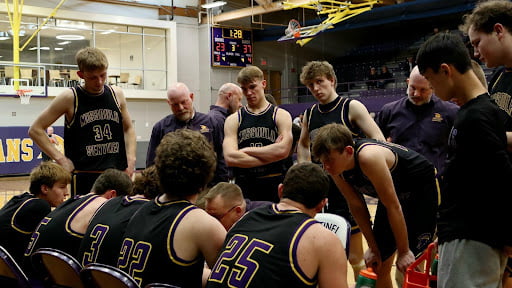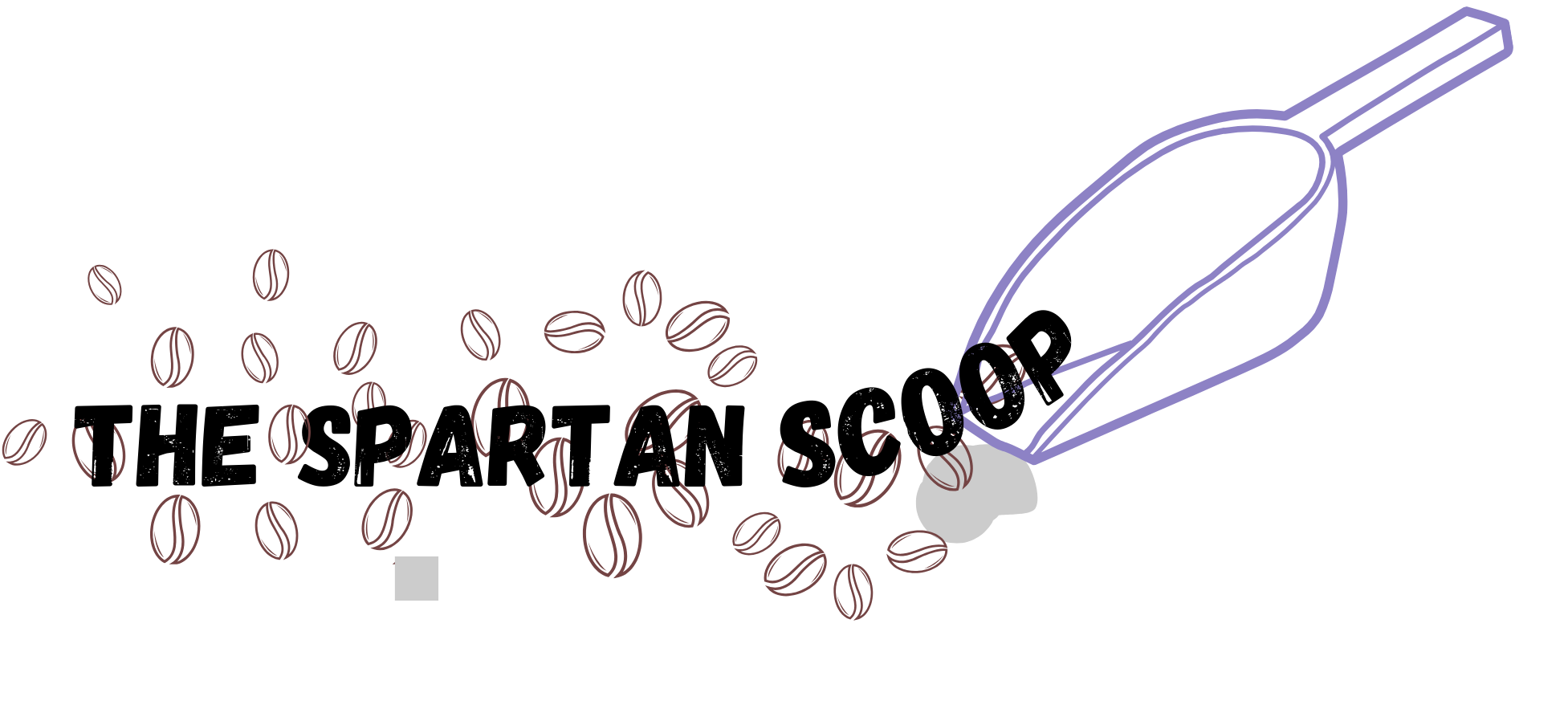Sentinel Boy’s Varsity and Junior Varsity

I wasn’t sure what to expect the first day I observed basketball practice. When I walked into the gym, I approached Head Coach Maki and asked him where he wanted me. He told me that anywhere was fine, so I took a seat on the top of the bleachers, pulled out my laptop, and began watching. I was looking at chaos. Everyone seemed to be running around aimlessly in every direction with basketballs. They weaved between one another, changing directions in an unpredictable manner. I continued to watch what seemed to be a misstep away from multiple players hitting each other. However, that fear never came to life. I was shocked as I started to realize that every player knew exactly what they were doing. They knew where everyone was, and where everyone was going to be. It was truly the definition of “controlled chaos,” and frankly mesmerizing to watch.
Shortly after this, Maki’s voice boomed throughout the gym. The players hustled to the end line, unphased by his volume. As I looked at everyone lined up to listen to Maki, I couldn’t help but smile. The players were full of energy, making jokes, laughing at each other, and even giving the coaches a little sarcasm. It was abundantly clear that everyone on that end line was there out of their own desire, not obligation. This energy and attitude was one of the first things that grabbed my attention and never let it go. I watched as the teams continuously joked with one another, including the coaches. This positive, light energy ceased to go away, even come game day. They made hard work look like a fun get together; constantly giving sarcastic comments, goofy responses, and genuine reactions. It was obvious that all the people in that gym: J.V. players, Varsity players, and coaches, thought of each other as equals and, in turn, treated each other as such. It was amazing to watch.
Despite how fun the players made everything look, there was no question of when it was time to focus. Everyone could be chit-chatting and goofing off, but the moment the coaches spoke, all of them would go silent and focus on the tasks at hand. I watched all of them actively listen as Maki and his co-coach, Josh Laslovich, gave an analysis of their last game. Afterwards, they asked the team their opinions on the matter. They discussed not only the flaws of the game, but the achievements as well, recognizing their strengths and weaknesses. This was specifically impressive to me, because acknowledging where there is room for improvement is easier said than done. They then used this conversation to direct them in practice and their choice of drills.
The coaches did an excellent job, giving thorough explanations of plays and valid reasoning for those plays. It was refreshing to see that they weren’t expected to function off of a blind faith, but rather explained strategies. One of my favorite things I observed was the question Laslovich constantly asked: “Does that make sense?” There was a clear, open line of communication and respect between coach and player that allowed, not only the execution of plays to flourish, but their relationships with each other as well.
The communication and respect between players was just as good as that of player and coach. They talked to each other not as teammates, but as friends. The players never failed to give encouragement when needed, and respectful critiques when mistakes occurred. My favorite part of their practices was when everyone would split off into small groups for free throws. During this time, the coaches would step back and let the players do their thing — exemplifying the coaches’ trust in them. They would all laugh and participate in conversation with one another, while practicing their shots simultaneously. I loved watching the relationships between both the players and the coaches. There was a strong sense of respect between all of them that was hard to miss. This alone was one of the coolest things I saw throughout their games and practices. They pushed each other to do better and trusted that others would push them too. They gave each other just as much support and critique and the coaches themselves. It led me to the conclusion that describing them as a family is far from an exaggeration.
Seeing the way J.V. and Varsity players function outside of game day, truly gives a whole new perspective while watching their games. I saw beautiful executions of the plays that originally looked like chaos to me. I saw the players continuously lift one another up, and strengthen the team’s overall morale through their positive, determined energy. One of my favorite things to see was the way coaches developed strategies based off of specific relationships. For instance, when the J.V. ‘s game against Flathead was starting to fall out of our favor, Coach Lashlavich would often put in a trio consisting of: number zero – Brady, number four – Luke, and number thirty – Eli. These three work extremely well with one another, not just during the game, but in practice as well. Due to attending their practices, I was able to see individual strengths along with the close and friendly nature between the three specifically. Luke has undeniable skill for communication on the team, along with consistent shots and quick thinking. Brady on the other hand, is arguably the fastest of the J.V. players, and uses this skill to get open and create openings for others. He is a critical team player who takes initiative and takes advantage of his skill to quickly relocate in order to save players who cannot pass the ball. This same skill proves to make him a great choice for closing and or creating crucial distance during games. These two, paired with Eli, form a dangerous unit for the opposing team. Eli seems to specialize in consistent layups and rebounds. He has proven to make quick, difficult layups, while surrounded by blockers along with excellently timed jumps to retrieve rebounds. The three of them make a powerful trio of communication, speed, reliability, and skill for manipulating the situation to their advantage. Ultimately making them a fantastic option for offense. Hence explaining a likely possibility for Lashlovich’s consistent choice to have the three of them on the court at the same time. Maki has succeeded in this as well. During the Varsity game against Glacier, Maki repeatedly put on a pair of players that proved to be a powerful duo: number 34 – Peyton, and number 10 – Drew. These two not only display a strong relationship during both game and practice, but a dangerous complement of skill to one another as well. Drew is excellent on offense. His aggressive play style and ability to quickly change courses, makes stopping him nearly impossible. He never fails to get open and constantly succeeds at difficult shots. Peyton on the other hand, is a stellar defensive player. His ability to predict the movement of opposing teams creates a major challenge for whomever he is blocking. In addition to this, his perfect timing as well as his high jumps make rebounds for the opposing team difficult, and if that wasn’t enough, his successful lay ups, directly afterwards, make him the perfect safety precaution for questionable shots. These two are an excellent pairing of players; Peyton’s defense creates strategic openings for Drew, who immediately recognizes the opportunity, and changes his course to take advantage of it. When this strategy isn’t ideal, Drew can resort to finding space to make difficult shots, knowing that Peyton will ensure the point in the case of failure. When put together, they are an undeniable danger to their opponents.
It’s important to note that one crucial factor to the success of both this duo and J.V.’s trio is their undeniable ability to work together. I’ve truly enjoyed watching the team’s relationship from their practices shine through on the court with each individual player. Their ability to push one another, work together, and use individual skills to create an amazing, overall team has been nothing short of extraordinary. They have truly been a pleasure to watch and report on.

"Whenever I'm about to do something I think 'would an idiot do that?' And if they would, I do not do that thing" - Dwight (The...

